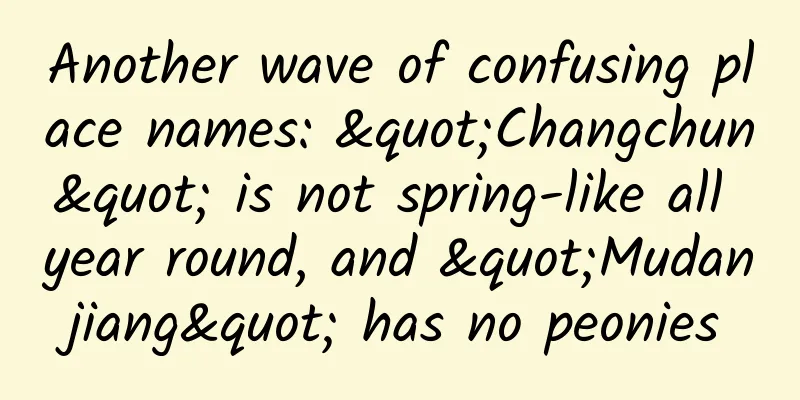Another wave of confusing place names: "Changchun" is not spring-like all year round, and "Mudanjiang" has no peonies

|
This article is about 3000 words Reading time: 8 min Is spring in Changchun long? Many times, our misunderstanding of place names comes from "taking the literal meaning of the words". For example, "Changchun" is obviously a city in the northeast, so how can it have "long spring"? How can "Mudanjiang", which is further north, have peonies blooming? Today, let’s have a look at the 2.0 version of confusing place names, starting with Changchun. "Eternal Spring Fort" or "Cha Ah Chong" The history of Changchun as a city is generally believed to have begun with the establishment of Changchun Hall by the Qing government. The "Evolution of Changchun County" records: "In the 56th year of Emperor Qianlong's reign, Gongglabutan, the Zasak Duke of Gorlos, recruited farmers to cultivate the nomadic land of the former banner. In the 5th year of Emperor Jiaqing's reign, a director was set up in Changchun Fort, named Changchun Hall." Originally, the Qing government divided the living areas of the Manchus and Mongolians into a "38th parallel", called the "willow border". Today's Changchun, Nong'an, Dehui, Jiutai (part) and other areas are all outside the border, and belonged to the front banner of Gorlos in those days. But in the context of the prosperity of the Kangxi and Qianlong eras, the population was a bit out of control. Farmers in the interior had no land to farm, so they could only start the "crossing the Guandong" mode. The Zasak of the front banner of Gorlos also accepted all the land reclamation workers who entered the country illegally, and just sat there waiting to collect the land rent happily. More and more people came. The industrious and bankrupt farmers worked hard to open up the land inside and outside the Great Wall, and frantically tested the edge of the Qing government's tolerance. Finally, in the fifth year of Jiaqing, the Qing government decided to "set up officials to suppress" and set up Changchun Hall here, calling it "borrowing land to support the people." The Qing government set up an administrative area parallel to the Guoerlos Front Banner here. At the beginning of the establishment of the government, there was no direct "Changchun Hall Director Tongpan Seal". A roundabout strategy was adopted to highlight the "land" power, and the "Guoerlos Director Tongpan Seal" was first made. After observing for four or five years and seeing that everyone had no objections, it was officially called Changchun Hall. The location of Changchun Hall is on a flat open land on the east bank of the Yitong River. Because it is very close to the "Changchun Fort", it is named "Changchun Hall", and the locals call it "Xinlicheng". From the history of Changchun Hall, it can be seen that the origin of the name "Changchun Hall" is closely related to "Changchun Fort". In the 30th year of Emperor Kangxi's reign, the Qing government decided to add a border opening period. Every spring, the Yitong Border Gate near the tribe would open up for trade. At this time, the Mongolians with livestock, the Han people with food, and the Manchus with their own specialties could exchange what they had at this gate. But over time, some people began to get restless and ignored the seasons. Even in summer, autumn and winter, they continued to trade secretly, hoping that the market that accompanied spring would last longer. Seeing this, General Jilin also gave everyone some leeway, using the method of "openly tightening but secretly loosening" to deal with the court. "Spring" really became "longer" here, so this nameless village was called "Changchun Fort" by people. Liao map. Source: Tan Qixiang's "Chinese Historical Atlas" However, some people believe that Changchun is simply a transliteration. In the Liao Dynasty, the emperor would go to Chagan Lake every spring to hunt, shoot wild geese, and eat the first fish banquet. They offered sacrifices to the heavens when breaking the ice to catch fish, and "Chaa Chong" was their slogan for offering sacrifices to the heavens, which sounds very similar to "Changchun". Some studies also believe that "Chaa Chong" did not stop at the Liao Dynasty, but can be traced back to the Sushen more than 2,000 years BC, which is the ancestor of the Manchu and Jurchen peoples. To this day, "Chaa Chong" is still another name for Changchun. The ubiquitous “transliteration area” Ancient phonetic transliteration is a good idea. Regardless of whether "Changchun" comes from the ancient Jurchen "Chaa Chong", there are many place names in the Northeast that are transliterated by ethnic minorities. For example, the Yitong River mentioned above means "huge, turbulent water" in Manchu. Yinma River is the transliteration of the Manchu "Yanluo" (Ilmun), and it may be named because the river floods during the flood season and floods people and livestock. Just as "Changchun" has nothing to do with "Changchun roseus"; "Mudanjiang" in Heilongjiang does not mean that peony flowers converge to form a river, but is the transliteration of the Manchu "Mudan Ula", which means "winding river"; "Mulan County" in Harbin is neither named after the "Mulan flower" nor to commemorate "Hua Mulan", but "Mulan" means "deer luring" in Manchu, which is the method used by the Manchu people to lure deer for hunting, which is also the origin of Mulan Hunting Ground. "Qiqihar" in Heilongjiang was originally called "Qichahali", which does not mean laughing together, but means "grassland" in Daur language. There is a "Fuyu County" and a "Taila County" in the city. "Fuyu County" is named after the Wuyur River. In Manchu, "Wuyur" means "low-lying". The low-lying Wuyur River did not flow into the ocean in the end, thus forming the famous wetland-Zhalong Nature Reserve. "Taila County" sounds like it is taken from "Misfortunes turn into blessings", but the legend is that a Mongolian lama once lived here and provided "flower-planting power" to nearby villagers to prevent smallpox. People named the place "Talaxi" out of gratitude, which means "cultivation" in Mongolian. Later, the Han people came and misheard it, thinking that "Talaxi" meant "Tailaqi". A similar situation also exists in Guangxi Zhuang language. They call "River" "Da", and "Ji" means "cold". "Da Ji" actually means that the river water is cold. They call the mountain pass or the valley "Geng", and "Wang" means Huang's family. "Gengwang" means that the village is difficult to pronounce and was first occupied by the Huang family. These names that look auspicious have nothing to do with human good wishes. However, those names that are truly auspicious are hidden. There is a mountain range in the southeast of Heilongjiang, which is a branch of Changbai Mountain. It is called Zhangguangcai Mountain. This mountain range looks like the home of "Zhang Guangcai", but it actually means "auspicious and auspicious", which comes from the Manchu "Zhegenchai". There is a "Bayan County" in the suburbs of Harbin, which comes from the Manchu "Bayan Susu", which means "rich land". Place names also play homophonic puns Once we open up our mind and re-examine these interesting place names from a multi-ethnic perspective, the answers to some names that may have puzzled us become clear. Every time I see "Baotou" in geography textbooks, I always feel a little puzzled. Why does it have a wrapped head? One theory is that it is a transliteration of "Botou", which refers to the former water transport terminal on the Yellow River in Baotou. Another theory is that this word comes from the Mongolian "Baoktu", which means "a place with deer", so it is also called "Lucheng". The "cooperation" in Hezuo City, Gansu Province is also related to animals. "Cooperation" is a homophone of "Heicuo" in Tibetan, which means "a place where antelopes live". "Jinghong" in Yunnan is Dai language, meaning "City of Dawn"; "Meigu" in Sichuan is a Yi language, meaning "hinterland"; Guangxi "Baise" is Zhuang language, which means "the place where you wash clothes"... The transliterated place names contain the wisdom of collective efforts in the integration of ethnic groups. There is a place in Tibet, which is transliterated as "Nichi" in Tibetan, and sounds the same as "Nichi". At that time, the sub-committee was located on a hillside above it, and someone suggested naming the area under the sub-committee "Nichi", but the homophony was not pleasant, so the name we are familiar with later, "Linzhi", was born. Whether some place names are transliterations or where they come from is worthy of continuous questioning and research by the academic community. For example, we usually explain "Dunhuang" literally in Chinese: "Dun means big. Huang means prosperous." However, most modern scholars believe that the etymology of "Dunhuang" is not Chinese. It is generally believed that "Dunhong" recorded in "Classic of Mountains and Seas" is the earliest name of Dunhuang, which may be a Chinese transliteration of the local minority language. It may be the transliteration of Tokhara, the Yuezhi people who lived between Dunhuang and Qilian at that time; or it may be the transliteration of "Tocharian", and it is inferred that Dunhuang is the former place where the Tocharians lived; others believe that it is the homophone of "Duohang" (meaning the place for reciting scriptures or the place for reciting scriptures) in the ancient Qiang language. Just like the origin of the place name "Changchun", the transliteration of ancient Chinese may need more research, but it undoubtedly brings more imagination and possibilities to readers and scholars. Breaking the routine, crossing history, and crossing ethnic groups, the multi-meaning place name makes the small piece of land three-dimensional. References: [1] Weng Youli. Research on the Origin of Changchun City Place Names[J]. Journal of Jilin Normal University (Humanities and Social Sciences Edition), 2012, 40(05): 56-58. [2] Bi Chunhui. Why is this city called "Changchun" [N]. Changchun Daily, 2018-06-27(011). [3] Tao Ran. A Sociolinguistic Study of Place Names in Changchun[D]. Shenyang Normal University, 2012. [4] Peng Xuekai, Wang Dianbin. Research on the Origin of Dunhuang Place Names[J]. Chinese Place Names, 2019(06):12-14. [5] Cui Yu. From Kaobianwu to Xinghua Village: Searching for Changchun Memories in the Corners[D]. Jilin University, 2016. [6] Jilin Provincial Local Chronicles Compilation Committee. The Birthplace of Changchun (Xinli Town) [EB/OL]. [7] Zhihu @龙龙. What are some place names that look like Chinese but are actually transliterated? [EB/OL]. 2017-11-14 https://www.zhihu.com/question/30518387/answer/176488590 [7] Lingge English. These Chinese place names are actually transliterations [EB/OL]. https://mp.weixin.qq.com/s/R4Ooc-zj8i-rA9-Sjkv4ng, 2016-02-02 END Author: Siyuan Editor | Zhan Xihui Proofreading | Gu Yue *This article is an exclusive article of "National Humanities and History". Readers are welcome to forward it to their friends. |
<<: Beware! The adulteration rate of such food for babies is as high as 70%!
Recommend
How difficult is it for Huawei to develop an operating system?
Some time ago, a piece of news was widely reporte...
How much of your storage capacity has WeChat and Alipay taken up? Exaggerated
Although WeChat is called Wei, it occupies 5G sto...
Notice of the State Council on Issuing the 13th Five-Year Plan for the Development of National Strategic Emerging Industries
The State Council issued the "Thirteenth Fiv...
WOT2016 Wang Qingyou: Listen to the Chief Architect Discussing Large APP Server Architecture
The WOT2016 Mobile Internet Technology Summit wil...
More than 100,000 users added in 5 days, revealing the "payment + fission" routine in the education industry!
Fission is a very popular concept this year, on p...
China's "first long text goblet" was unearthed in Yunmeng, Hubei!
In September 2020, the Hubei Provincial Institute...
Unleash your potential
Introduction to resources to ignite the potential...
The new Meizu 15 is about to be released, but internal executives are having an internal conflict. What is going on?
There was only one week left until Huang Zhang re...
What kind of market is e-sports that even Wang Sicong is attracted to?
On the afternoon of May 11, it was pouring rain i...
How were games developed 20 years ago?
[[145405]] Someone asked on Zhihu: "There ar...
Does Pu'er tea cause cancer? Drinking tea can cause kidney stones? Do you believe these 5 rumors about tea?
As the ancestor of the beverage industry, tea is ...
Heavy rain! Red alerts issued in many places! How to prevent and respond to disastrous weather scientifically?
Heavy rain is coming! Since May 2, the heaviest r...
Zebra stripes, neither camouflage nor cooling? Uncovering the true purpose of black and white stripes
Did you know that the black and white stripes on ...
Traffic, winners, paid future... this year of content entrepreneurship!
The top picture of this article is Luo Zhenyu, th...









